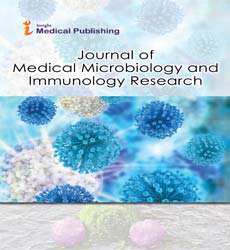ISSN : 2634-7164
Journal of Medical Microbiology and Immunology Research
Identification of Bacterial Samples Using Laser Spectroscopy
Abstract
The laser-induced plasma spectroscopy (LIPS) technique was used to analyze two different species of bacteria, Escherichia coli (B1) and Micrococcus luteus (B2), placed on glass slides. Spectrolaser software was used to examine LIPS spectra. The glass substrate's LIPS spectrum was compared to bacterium spectra. In airborne bacterial samples, atomic emission lines were observed. Two carbon lines at 193.02 nm and 247.88 nm, as well as one hydrogen line at 656.28 nm, occurred in bacterial samples B1 and B2, with intensity different ratios. Bio-samples such as bacteria and cancer cells contain significant amounts of carbon and hydrogen. The results of a study of the LIPS spectra of samples in He and Ar atmospheres are also reported. In an Ar environment, Ni lines showed solely in the B2 sample. We may conclude from the current experimental findings that the LIPS technique has a possibility in the detection and identification of different types of bacteria
Open Access Journals
- Aquaculture & Veterinary Science
- Chemistry & Chemical Sciences
- Clinical Sciences
- Engineering
- General Science
- Genetics & Molecular Biology
- Health Care & Nursing
- Immunology & Microbiology
- Materials Science
- Mathematics & Physics
- Medical Sciences
- Neurology & Psychiatry
- Oncology & Cancer Science
- Pharmaceutical Sciences
